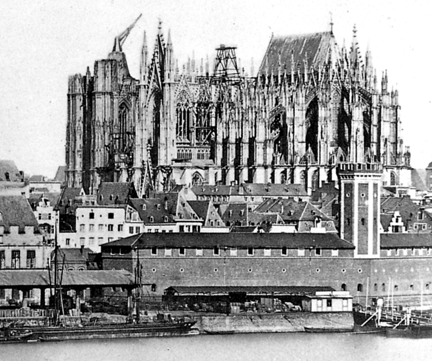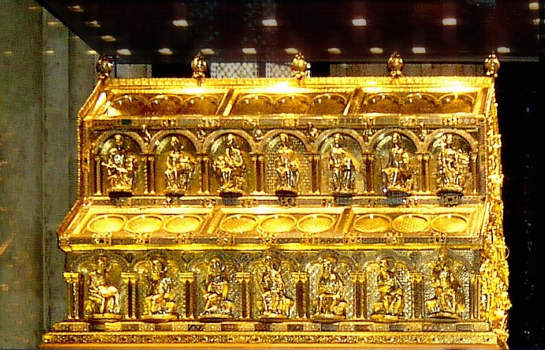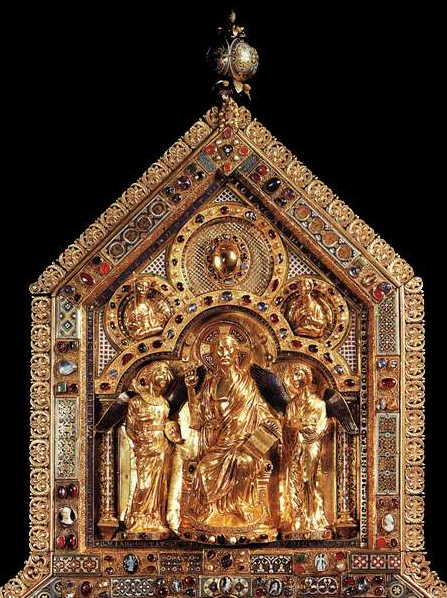Part II. The Hansa Lands and France
Chapter 27. Köln [November 1, 1347]
Cultural Explanations
 |
Part II. The Hansa Lands and France Chapter 27. Köln [November 1, 1347] Cultural Explanations |
|
|
In this chapter Bávlos meets the builder of the Cathedral of Cologne. | ||
| Bávlos, Nieiddash, Köln Cathedral, Gerhard with builder's T-square |
In this chapter, Bávlos begins his trek through the Hanseatic lands of the Holy Roman Empire. He has come to the city of Köln (Cologne), where he visits the grand Cologne Cathedral, and hears the story both of the city's great relics—those of St. Ursula and the Eleventh Thousand Virgins, and the grand relics of the Three Kings, housed in a magnificent sarcophagus designed and partly created by Nicholas of Verdun. And he has a troubling discussion concerning the value of completion with Master Gerhard, the legendary head builder of the unfinished cathedral.
The city of Köln was a major trading city in the mid-fourteenth century: a powerful urban center with considerable wealth and prestige. The legend of St. Ursula was an important tradition in Köln as well as in the whole of Europe, and the Church of St. Ursula was a major pilgrimage site. Columbus eventually named the Virgin Islands after these saints, and the order of nuns known as the Ursulines was founded in honor of St. Ursula and her companions. The legendary details of St. Ursula's story led church officials to cast doubt on the cult during the twentieth century, but the veneration of St. Ursula was strong in the fourteenth century when Bávlos visits Köln.
The circumstances by which the relics of the biblical magi came to reside in Köln reflects the strategic uses of holy relics during the medieval era. The relics were said to have been brought to Europe by Constantine's mother, St. Helena, and eventually became housed in the cathedral at Milan (the old woman's "Meiland"). Bávlos will hear an Italian side of the story in a later chapter.
The Cathedral of Köln was begun in 1248 to house the relics. Work continued unabated on the cathedral until 1499, when the project came to a halt due to lack of funds. For centuries, the medieval crane of the abandoned worksite towered above the city, reminding all of the unfinished cathedral, and perpetuating the legend of the master builder Gerhardt who wagered his soul that he could complete the cathedral before the devil could complete a master work of his own. According to the legend, Gerhard is tricked into revealing the technological secret that would allow the devil to finish his task first, and, armed with that knowledge, the devil completes his laborts and claims the builder's soul. You can read a version of the legend HERE. The historical Master Gerhard was responsible for the completion of the eastern transept of the cathedral, which opened as a separate temporary worship space in 1322, while work on the rest of the structure continued. This is the area that Bávlos visits with his hot-tempered guide.
 |
| Unfinished cathedral with medieval crane, 1856; photo Wikipedia Commons |
Work resumed on the cathedral only in the twentieth century.
The grand Shrine of the Three Kings is justly considered one of the artistic masterpieces of the medieval era.
 |
 |
| Shrine of the Three Kings; Wikipedia Commons | Detail; image from www.lib.art.com |
The goldsmith and enamelist Nicholas of Verdun (1130-1205) began work on the enormous reliquary in the late twelfth century but died before its completion. Art historians have long bemoaned the inferiority of the side of the reliquary completed by his followers after his death. You can find detailed images of the various pictorial panels of the work HERE.